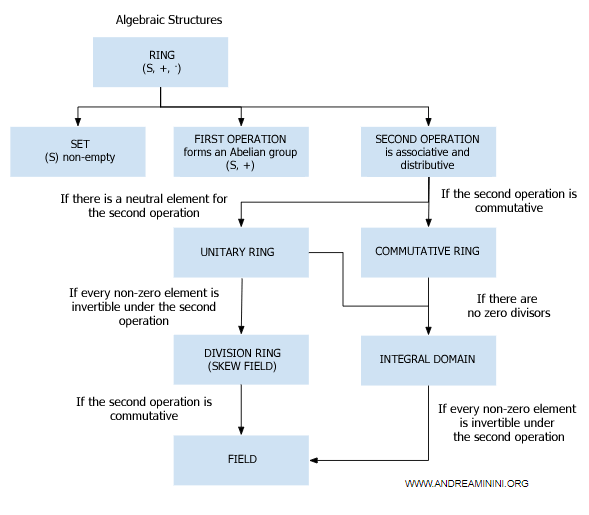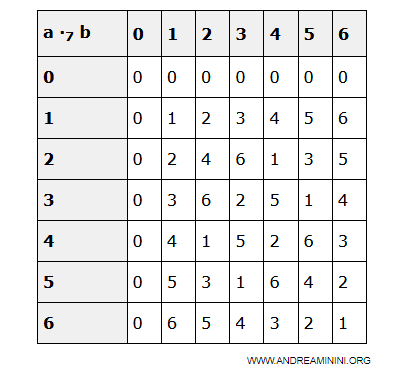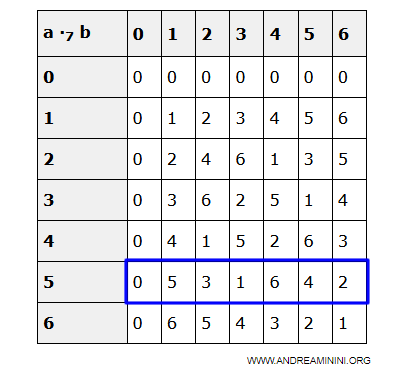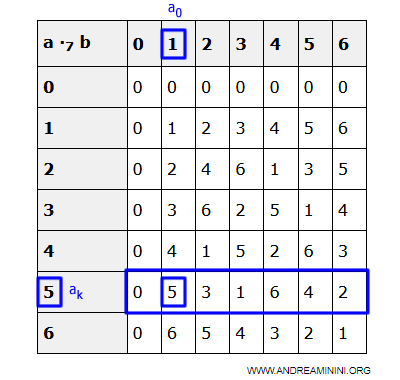Integral Domains
An integral domain is a commutative and unital ring (S, +, ·) that has no zero divisors. $$ \forall \ a, b \in S \ , \ ab=0\ \Rightarrow\ (a=0\ \lor\ b=0) $$
In simpler terms, an integral domain is a commutative ring in which the product of two elements is zero only if at least one of them is zero.
To verify whether a commutative ring (S, +, ·) is an integral domain, we must demonstrate that there are no zero divisors in the set S.
What is a zero divisor? In a commutative ring (S, +, ·), a non-zero element a ≠ 0 in set S is called a zero divisor if there exists another non-zero element b ≠ 0 in set S such that ab = 0.
A Practical Example
The set of integers Z forms a ring (Z, +, ·) with respect to addition and multiplication.
$$ (Z,+,\cdot) $$
This is a commutative ring because multiplication also satisfies the commutative property.
The product of two non-zero integers a ≠ 0 and b ≠ 0 is always non-zero.
$$ \forall \ a,b \in Z \ , \ a \ne 0 \ , \ b \ne 0 \ \ \Longrightarrow \ \ ab \ne 0 $$
Note. If two integers have the same sign (positive or negative), their product is always positive. If they have different signs, their product is negative. Therefore, if the product of two integers is zero $$ ab = 0 $$ at least one of the factors must be zero. $$ a \cdot 0 = 0 \cdot a = 0 $$
As a result, there are no zero divisors in the set Z.
This means that the commutative ring (Z, +, ·) is an integral domain.
Example 2
Now, let's consider the set of residue classes modulo 6.
$$ Z_6 = \{ 0,1,2,3,4,5 \} $$
The set Z6 forms a commutative ring (Z6, +, ·) with respect to addition (+) and multiplication (·).
$$ (Z_6,+, \cdot) $$
To check for zero divisors, we can construct the multiplication table for the ring.
| a ·6 b | 0 | 1 | 2 | 3 | 4 | 5 |
|---|---|---|---|---|---|---|
| 0 | 0 | 0 | 0 | 0 | 0 | 0 |
| 1 | 0 | 1 | 2 | 3 | 4 | 5 |
| 2 | 0 | 2 | 4 | 0 | 2 | 4 |
| 3 | 0 | 3 | 0 | 3 | 0 | 3 |
| 4 | 0 | 4 | 2 | 0 | 4 | 2 |
| 5 | 0 | 5 | 4 | 3 | 2 | 1 |
In this case, there are three zero divisors: the numbers 2, 3, and 4.
For instance, the product 2·3 equals zero because the remainder is zero.
$$ 2 \cdot 3 \equiv 0 \ \text{mod} \ 6 $$
Explanation. To calculate the product of 2 and 3: $$ 2 \cdot 3 = 6 $$ Now, I find the remainder of dividing the result (2·3=6) by 6: $$ 6 \div 6 = 1 \ \text{remainder} = 0 $$ The remainder is zero, so in the modulo 6 system, 2·3=0. The same applies to the product 3·2=0.
Thus, because zero divisors exist, the commutative ring (Z6, +, ·) is not an integral domain.
In general, a commutative group Zn is an integral domain only if the number of elements (n) is a prime number.
Example 3
Now, consider the set of residue classes modulo 7.
$$ Z_7 = \{ 0,1,2,3,4,5,6 \} $$
In this case, the number of elements is prime (n=7).
The set Z7 forms a commutative ring (Z7, +, ·) with respect to addition (+) and multiplication (·).
$$ (Z_7,+, \cdot) $$
Let's create the multiplication table to check for zero divisors.
| a ·7 b | 0 | 1 | 2 | 3 | 4 | 5 | 6 |
|---|---|---|---|---|---|---|---|
| 0 | 0 | 0 | 0 | 0 | 0 | 0 | 0 |
| 1 | 0 | 1 | 2 | 3 | 4 | 5 | 6 |
| 2 | 0 | 2 | 4 | 6 | 1 | 3 | 5 |
| 3 | 0 | 3 | 6 | 2 | 5 | 1 | 4 |
| 4 | 0 | 4 | 1 | 5 | 2 | 6 | 3 |
| 5 | 0 | 5 | 3 | 1 | 6 | 4 | 2 |
| 6 | 0 | 6 | 5 | 4 | 3 | 2 | 1 |
In this case, there are no zero divisors.
Therefore, the commutative ring (Z7, +, ·) is an integral domain.
Remarks
Here are some key points about integral domains:
-
If the multiplicative inverse (second operation) exists for every non-zero element, the integral domain is a field.

- A finite integral domain is also a field
An integral domain becomes a field if all elements are invertible under multiplication (the second operation).
Proof. Consider an integral domain (D, +, ·) with a finite number of n distinct elements: $$ D=\{ a_1,a_2, ..., a_n \} $$ It's important to note that all elements are distinct.
Example. To see how this works with numbers, let’s use the finite set Z7 $$ D=\{0,1,2,3,4,5,6 \} $$ and the integral domain (Z7, +, ·).

Let’s take any non-zero element ak in D (ak ≠ 0). $$ a_k \ne 0 $$ Now, construct a function that multiplies ak by every other element: $$ f: a_k \cdot a_i $$ Since we get distinct products, the function f is injective. Because D is finite, f is also surjective.
Example. If we choose ak = 5 in Z7, the products with the other elements of Z7 are all distinct.

This means that ak must be equal to the product of ak with some element a0 in D $$ a_k = a_k \cdot a_0 = a_0 \cdot a_k $$
Example. In this numerical example, if ak = 5, then a0 = 1 because $$ 5 = 5 \cdot 1 = 1 \cdot 5 $$

Thus, any element x in D is equal to the product of ak and some ai $$ x = a_k \cdot a_i $$
Example. Look at the multiplication table for Z7. The product of ak = 5 with elements of Z7 generates all elements of Z7. $$ 5 \cdot 0 = 0 \\ 5 \cdot 1 = 5 \\ 5 \cdot 2 = 3 \\ 5 \cdot 3 = 1 \\ 5 \cdot 4 = 6 \\ 5 \cdot 5 = 4 \\ 5 \cdot 6 = 2 $$
Since ak = ak · a0, $$ x = ( a_k \cdot a_0 ) \cdot a_i $$ Using the commutative property: $$ x = ( a_0 \cdot a_k ) \cdot a_i $$ And by the associative property: $$ x = a_0 \cdot (a_k \cdot a_i) $$ Knowing that x = ak · ai: $$ x = a_0 \cdot x $$ Because multiplication is commutative in an integral domain, $$ x = a_0 \cdot x = x \cdot a_0 $$ Therefore, a0 = 1 is the multiplicative identity in D $$ a_0 = 1 $$ This proves the existence of a multiplicative identity in D. Consequently, the identity element 1 exists in D and is equal to the product of ak and some aj: $$ 1 = a_k \cdot a_j $$
Example. In the numerical example of Z7, with ak = 5 and aj = 3, $$ 1 = 5 \cdot 3 $$ So, the inverse of ak = 5 is ak-1 = 3.
In conclusion, all non-zero elements in D are invertible.
Example. In the numerical example of Z7, all non-zero elements in Z7 have inverses. For instance, the inverse of 1 is 1, the inverse of 2 is 4, the inverse of 3 is 5, the inverse of 4 is 2, the inverse of 5 is 3, and the inverse of 6 is 6.

As a result, the integral domain (D, +, ·) is a field.
And so on.
